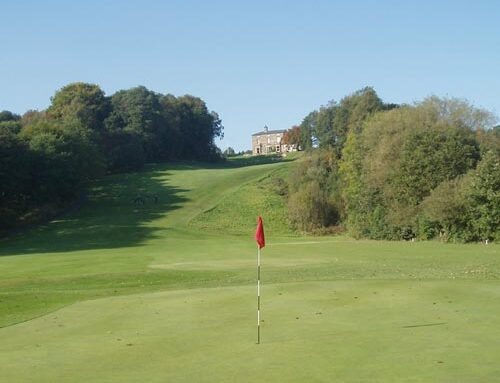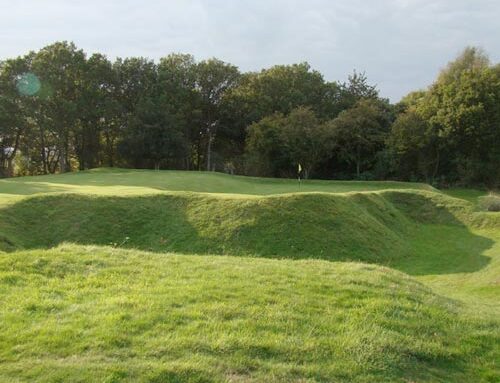Swinley Forest Golf Club
Berkshire, England
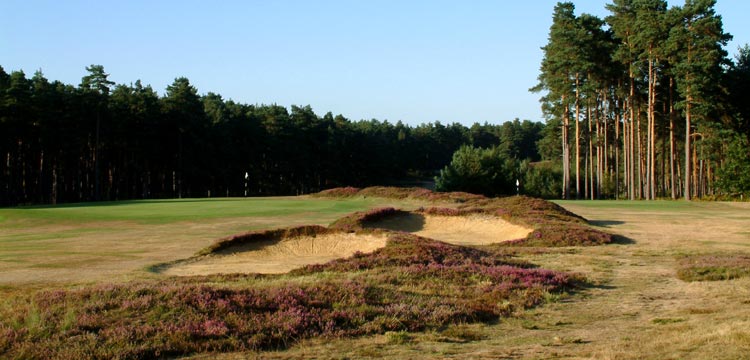
The natural green sites of the eleventh and fourteenth holes pictured above highlights one of the reasons why Swinley Forest is so special.
Many courses and golf clubs gain fame through hosting significant golf tournaments. Interestingly enough, many of the consensus world’s top courses have no tournaments and/or actively promote not having outside events. Examples include National Golf Links of America, Sand Hills, The Golf Club and Cypress Point.
Through their various tournaments over the years, Sunningdale and Wentworth have received much attention as the leading courses around greater London. However, the finest example of the pleasures of heathland golf is to be found at Swinley Forest in Ascot. Swinley is as far removed from tournament golf as any club in the world could be and is all the better for it. Harry Colt believed it to be his finest course. Unlike Dr. MacKenzie, Colt was not prone to self-promotion, so his assessment may indeed carry weight.
The course is just over 6,000 yards from the back markers and has a par of 69. In fact, the authors prefer the course shorter still, with the 15th hole played as a long par four reducing par to 68 and the yardage under 6,000.
Much has been written about the serenity and ambiance found at Swinley Forest. It is indeed deserved and provides the golfer with an unmatched solitude from which he can enjoy a game. However, make no mistake about it: Swinley couples outstanding golf holes with its first-rate atmosphere.
One of the features that sets Swinley apart is its collection of par three holes. Colt stalked the property until he found the natural green sites for these short holes. The 4th hole has a deep pit protecting the front left, the 8th green is set on a ledge with a twelve foot drop to the right, the 10th is across a valley to a green with a hog back ridge in its middle, the 13th is downhill to a most attractively bunkered green, and the 17th features a small pulpit green. These holes capsulize the appeal of Swinley Forest: they place exact demands on the highest skilled golfer, yet remain enjoyable to those less skilled (please note: Colt’s love of the Old Course at St. Andrews is well documented and it had a great influence on his design career). Cumulatively, these five holes are the finest collection of one shot holes the authors have seen in the British Isles, surpassing those at Woodhall Spa and even Rye.
Having found the par three holes, Colt then surrounded them with a range of superb par four holes. In particular, the long ones found at the 6th, 9th, 12th and 15th holes give the course its considerable appeal to low markers. Several European PGA Tour members find Swinley Forest best encourages them to keep their games finely honed, as it calls for all the shots.
From the tee shot on the 2nd hole through the 17th hole, the golfer faces one enticing shot after another. Unlike other heathland courses where invariably there are two or three indifferent holes that disrupt a sense of momentum, one appealing hole follows another at Swinley, as sure as one day will follow the next.
The spacing of the par threes is excellent; there is a short par four on each nine (the 3rd and the 11th ) and the big fours (the 6th, 9th, 12th , and 15th) are – literally – perfectly spread as well. Thus the course balance, variety and pacing are exemplary and serve as glowing testimony to the skills of Colt.
No wonder Colt would talk about ‘a craving for my usual game around the Swinley Forest course.’ And what a perfect word to describe the place – ‘craving.’ How many of the courses built since WWII do you actually crave to play? Not many is our guess.
Holes to Note
Forth hole, 185 yards; One of the finest inland(or otherwise) one shotters in the British Isles, this Redan green is set on a natural shelf. A savage front left bunker gathers indifferent shots with swift certainty. The distance is difficult to gauge, as the golfer is sheltered from the wind by the green and frequently underestimates just how much uphill the shot really is., the proper club may be two more than the golfer first suspects. The green has a false front and is swift from back to front.
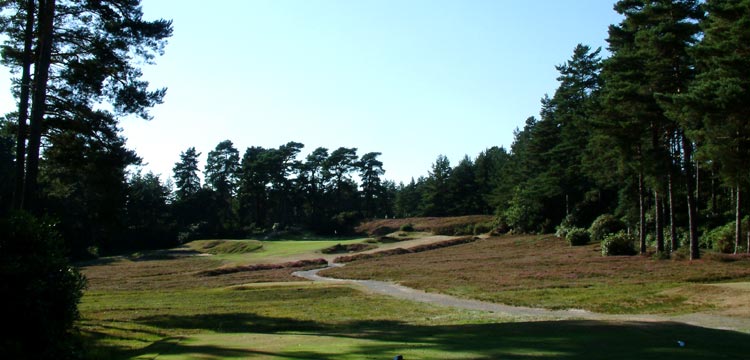
Swinley Forest is world renowned for its set of one shot holes. The Redan fourth may well be the best of the bunch.
Sixth and Seventh holes, 425 and 400 yards, respectively; Though not as well known, these two par fours are the equal of the 5th and 6th holes at Sunningdale (Old). In common with them, the sweeping view from the tee is one that will be long cherished. These uninterrupted vistas epitomize the spaciousness of heathland golf and are all but lost on the tree lined courses in the United States.
Ninth hole, 435 yards; A visually stunning heathland hole, the tee is well above the fairway, which sweeps from right to left. The entire left side of the fairway is bordered by heather. The golfer who goes right has plenty of room but begins to make the hole play intolerably long. The approach shot is uphill to a small green that is appropriately bunkerless and open in front.
Tenth hole, 210 yards; On a coursenot much more than6,000 yards, Colt nonetheless figured out how to ask the golfer to hit every club in the bag. Its lengthy two shotters and one shotters hold the attention of even the best golfer.
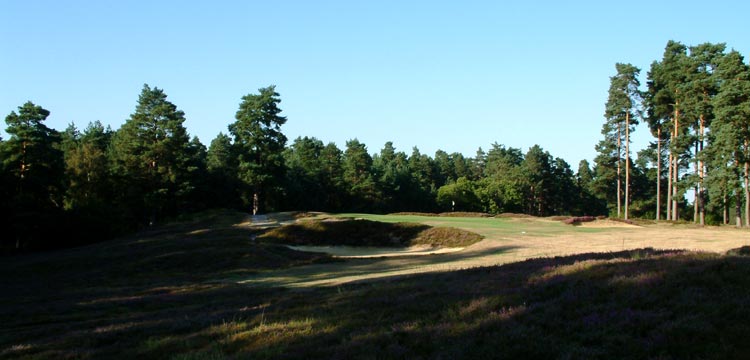
The large bunker that grabs the eye is a full twenty yards from the front edge of the putting surface.
Twelfth hole, 455 yards; A unique hole featuring the most convoluted green at Swinley Forest. A hard running shot that chases up onto the green is a delight to watch. The green is set against a bank, which in May becomes a violet wall of rhododendrons. A very fine example of a half-par hole.
Thirteenth hole, yards;
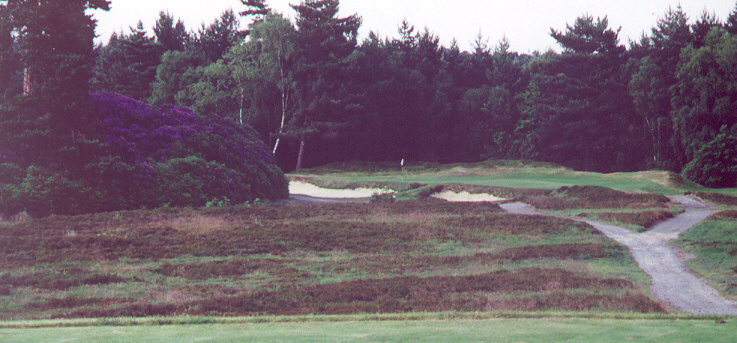
The thirteenth green angles away and to the left from the golfer on the tee.
Fifteenth hole, 440 yards;

Swinley Forest’s 6,000 yards packs plenty of challenge, as typified by the uphill 440 yard fifteenth hole.
Sixteenth hole, 415 yards; This two shotter features the deepest green on the course at over 40 yards. Just past half way back on the green, there is a three foot rise in the green. A number of appealing approach shots result, some are aerial and others running, dependent upon the hole’s location for the day.
Seventeenth hole, 170 yards; A perfect one shotter for this point in the match. The pushed up green is some seven feet above its surrounds and falls away on all sides. A valley in front, a gully to the right and back, or one of two mean bunkers to the left gather many a tee ball. The green is none too big and is difficult to putt. Yet because of its length, the hole remains within the capability of all golfers. A two to a five awaits.
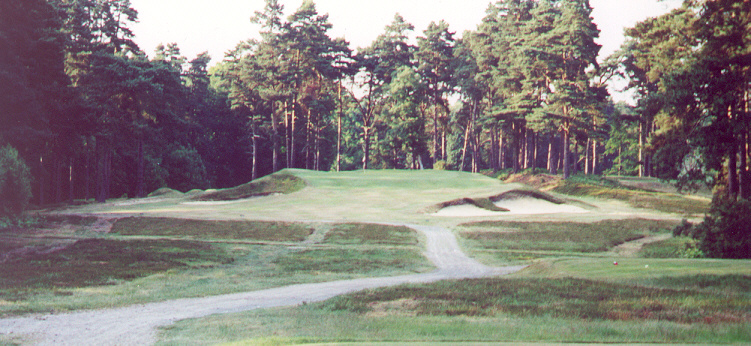
The knob-like seventeenth green is hard to hit, especially at this point in a match. One thing is for sure though: it will have taken your partner and you less than three hours to reach this tee.
What will it take for developers and course architects to break out of their 7000 yard par 72 cookie cutter courses of today? Swinley Forest packs more interesting shots and possesses more memorable holes than any 7,000 yard course built since WWII. Harry Colt gave us a perfect golf course and he did it in 1910. The virtues of golf course design on display at Swinley Forest make it both a model course and club.
Why was Swinley Forest Colt’s favorite (or ‘least bad’) course? The authors believe that he appreciated that Swinley met his own criterion the best – ‘the real test of a course: is it going to live?’ Swinley Forest emphatically will continue to do so for generations of golfers to come.
The End



![Minchinhampton (Old) [2016]](https://golfclubatlas.com/wp-content/uploads/2018/09/Minchinhampton-500x383.jpg)
![St. Enodoc (Church) [2017]](https://golfclubatlas.com/wp-content/uploads/2017/11/St.-Enodoc-500x383.jpg)
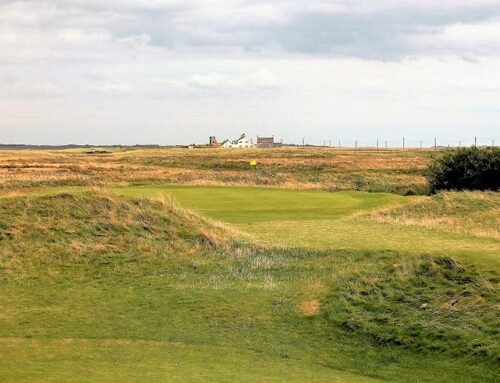
![Sunningdale (Old) [2014]](https://golfclubatlas.com/wp-content/uploads/2017/11/Sunningdale-Old-Course-500x383.jpg)
